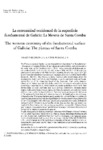Mostrar o rexistro simple do ítem
La extremidad occidental de la superficie fundamental de Galicia: La Meseta de Santa Comba
| dc.contributor.author | Pagés Valcarlos, J. L. | |
| dc.contributor.author | Vidal Romaní, Juan Ramón | |
| dc.date.accessioned | 2010-01-22T13:26:29Z | |
| dc.date.available | 2010-01-22T13:26:29Z | |
| dc.date.issued | 1997 | |
| dc.identifier.citation | Cadernos do Laboratorio Xeolóxico de Laxe, 1997, 22: 133-149 ISSN: 0213-4497 | es_ES |
| dc.identifier.issn | 0213-4497 | |
| dc.identifier.uri | http://hdl.handle.net/2183/6283 | |
| dc.description.abstract | [Abstract] The Plateau ofSanta ir Comba is a very degraded rest ofan old surface (Late-Mesozoic -Paleogene), ofcomplex history. It has a mean altitude of400 m, and it is located in the western part of the Coruñan province. Their main geomorfological elements are: the residual reliefs (Ievels Al, A2, A3, A4, between 500 and 700 m of altitude), the platform or basal surface of the Plateau ofSanta Comba, between 400 and 500 m (A6 and A5) and the several flats that compond the degradation surface ofthe basal surface (levels Bl, B2, Cl). The Plateau of Santa Comba is the westernmost secror the Fundamental Surface of Galicia, and therefore, it can be correlated with the Fundamental Surface of the Hesperian Massif of the Peninsula. Their etche character (chemical corrosion) is geomorfologicaly evident for the existence of residual forms (inselbergs) conserved on it. They consist of pseudo apalachian reliefs with elear development of rocky platforms and basal carvings, sometimes multiple (flared slopes), and smaller forms, (vasque, tafoni, etc) that are conserved specially well on the older residual reliefs. The layout of the old fluvial network, previous ro the definition of the western Galician Rías, still remains drawn on the basal surface of the Plateau ofSanta Comba. This layout has been partly used by the present Xallas river, although fossil reaches are also conserved, distinguishables for the disproportionate dimensions of the valley compared with the actual secondary net associated ro them. Both in the periphery of the Plateau of Santa Comba and in their interior, they are located the heads ofthe fluvial net generated as aconsequence ofthe opening ofthe Atlantic Ocean and the alpine compression (since Late Mesozoic ro roday). They have affected the old fluvial net by means of processes of captures. Finally, the genesis for etching (chemical corrosion) of the Plateau ofSanta Comba as well as other big forms associated ro it, (Ría de Muros, Meridian Depression and satellite depressions , residual reliefs, etc.) allow us to propose a new genetic model for the reliefofwestern Galicia, more elose ro the postulate forVON RICHTHOFEN (1901), with evacuation of the regolith, and exposing of the etche surfaces (chemical corrosion) for the fluvial activity than to the traditional actual model based on the blocks tecronic. | |
| dc.language.iso | spa | es_ES |
| dc.publisher | Universidade da Coruña | es_ES |
| dc.subject | Fundamental surface | es_ES |
| dc.subject | Pseudo apalachian relief | es_ES |
| dc.subject | Galician rías | es_ES |
| dc.subject | Inselberg | es_ES |
| dc.subject | Undetermined hillsides | es_ES |
| dc.subject | Stepped slopes | es_ES |
| dc.title | La extremidad occidental de la superficie fundamental de Galicia: La Meseta de Santa Comba | es_ES |
| dc.title.alternative | The western extremity of the fundamental surface of Galicia: The plateau of Santa Comba | |
| dc.type | info:eu-repo/semantics/article | es_ES |
| dc.rights.access | info:eu-repo/semantics/openAccess |






